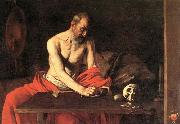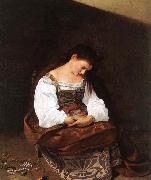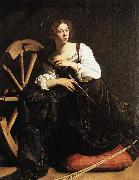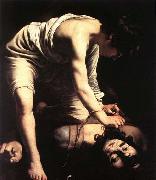
|
Artists
Index
|
||
|
Caravaggio
|
||
|
St Jerome 1607 Oil on canvas new21/Caravaggio-844662.jpg Måleriet identifieringen:: 62377 |
117 x 157 cm St John Museum, La Valletta This picture of the holy scholar was made for Ippolito Malaspina, a Maltese knight whose coat of arms is on the wooden panel to the right. He was connected by marriage to Caravaggio's patron Ottavio Costa and was a confidant of the Grand Master, who may have been used as the model for the saint (similarly Van Dyck was to use the sister of the Queen of England as model for the Madonna). The saint does indeed look like the knight in a recently discovered portrait by Caravaggio, who has been identified by some as Wignacourt himself. The composition is planned in terms of triangles. One rises from the table to the saint's head, another has its apex at the cardinal's hat on the wall to the left, a third recedes to the bedstead at the back on the right. This simple design helps convey an idea of simplicity. St Jerome has no halo, his workbench is rudimentary, he does not own any folios, he has one candle to see by, a crucifix to meditate on, a stone to beat against his chest, and a skull to remind him of his mortality. He is partly naked because he lives an eremitical life in the desert of Judaea. A steady light shines on his torso and picks out the red cloak round his legs. The source of the light is outside the picture, and can be interpreted as Christ, Light of the World | |
| |
|
|
|
|
||
|
Magdalene new21/Caravaggio-676746.jpg Måleriet identifieringen:: 62386 |
122,5 x 98,5 cm Galleria Doria-Pamphili, Rome This picture and The Rest on the Flight into Egypt must have been painted around the same time, for the same girl sat for the Magdalene and the Madonna. On this occasion, however, there are none of the usual signs of a religious scene such as a halo. A young girl, seen from above, is seated on a low stool in one of Caravaggio's favourite cave-like settings, with a triangle of light high up on the wall behind her. Discarded jewellery - a string of pearls, clasps, a jar (perhaps holding precious ointment) - lies on the floor. The girl's hair is loose, as if it has just been washed. Her costume, consisting of a white-sleeved blouse, a yellow tunic and a flowery skirt, is rich. Bellori, who gives a careful description of this picture, which he came across in the collection of Prince Pamphilj, regards its title as an excuse; for him it is just a naturalistic portrayal of a pretty girl. This seems to show a willful failure to understand Caravaggio's intention or the wishes of the man who commissioned it, Monsignor Petrignani. The repentant Mary Magdalene, like the repentant Peter, was a favourite subject of Counter-Reformation art and poetry, which valued the visible expression of the state of contrition 'the gift of tears'. Caravaggio's heroine is sobbing silently to herself and a single tear falls down her cheek. She is, as it were, poised between her past life of luxury and the simple life she will embrace as one of Christ's most faithful followers. It is a sign of the painter's skill that he makes this inner conflict moving at the same time as he makes its representation delectable. Although nothing painted in the sixteenth century is as emotive as the statue in wood of the haggard saint carved by Donatello (c.1456-60), by the time Titian's bare-breasted Magdalene of the 1530s (Palazzo Pitti, Florence) had become the more modest and affecting Magdalene of the 1560s, there had been a move in religious sensibility towards the humble and pathetic, a change which thirty years later Caravaggio could take for granted | |
| |
|
|
|
|
||
|
St Catherine of Alexandria new21/Caravaggio-285856.jpg Måleriet identifieringen:: 62387 |
173 x 133 cm Thyssen-Bornemisza Collection, Madrid The painting formerly belonged to Cardinal Del Monte, one of the artist's patrons. Here we see a single female figure in an interior devoid of architectural allusions. The image appears with a boldness and an immediacy that combine the nobility of the subject (St Catherine was a king's daughter) with the almost plebeian pride of the model (no doubt a Roman woman of the people, who appears on other paintings of the artist, too). The breadth of conception and realization, and the perfect mastery of a very difficult composition (the figure and objects completely fill the painting, in a subtle play of diagonals) are striking. Caravaggio here chose a "grand" noble approach that heralds the great religious compositions he would soon do for San Luigi dei Francesi. The extraordinary virtuosity in the painting of the large, decorated cloth is absorbed as an integral part of the composition. This is something his followers would not often succeed in doing, for they frequently dealt with the single components of the painting individually, with adverse effects on the unity of the whole. | |
| |
|
|
|
|
||
|
The Martyrdom of St Matthew new21/Caravaggio-334954.jpg Måleriet identifieringen:: 62389 |
1599-1600 Oil on canvas, width of detail: 90 cm Contarelli Chapel, San Luigi dei Francesi, Rome A boy who acts as altar-boy to the old man, whose service has been interrupted, flees screaming to the right. He is one of those expressive studies of emotion which, like the Medusa in Florence, have contributed greatly to Caravaggio's renown. Author: CARAVAGGIO Title: The Martyrdom of St Matthew (detail) , 1551-1600 , Italian Form: painting , religious | |
| |
|
|
|
|
||
|
David new21/Caravaggio-582367.jpg Måleriet identifieringen:: 62390 |
110 x 91 cm Museo del Prado, Madrid This painting addresses the subject of David and Goliath, which the artist repeatedly dealt with later in his career, with a perfect linearity of means and intelligence of iconographic invention. As in the early Renaissance, David is shown as the adolescent who triumphs not by his strength, but by his power of character and his faith. The oblique pose of the figure (David stands partly parallel to the picture plane) is constructed with admirable skill. Caravaggio has a particular importance for Spain, for he originated the realist and 'tenebrist' style of painting that enjoyed such development and popularity there in the work of such artists as Ribera and Zurbar?n. This mature work demonstrates the fundamentals of his art: an emphatic solidity created by a harsh contrast of light and shade; the immediacy created by staging the action right in the foreground, and eliminating all superfluous space around it (conventionally, David would have been given room to stand up, so to speak,', ', ', ', ', ', ', '); the elimination of decoration, such as colour or elegant posture, in order to concentrate on the drama alone | |
| |
|
|
|
|
||
| Föregående Konstnär Nästa Konstnär | ||
|
Also Buy::. For Following Paintings / Artists / Products, Please Use Our Search Online: |










